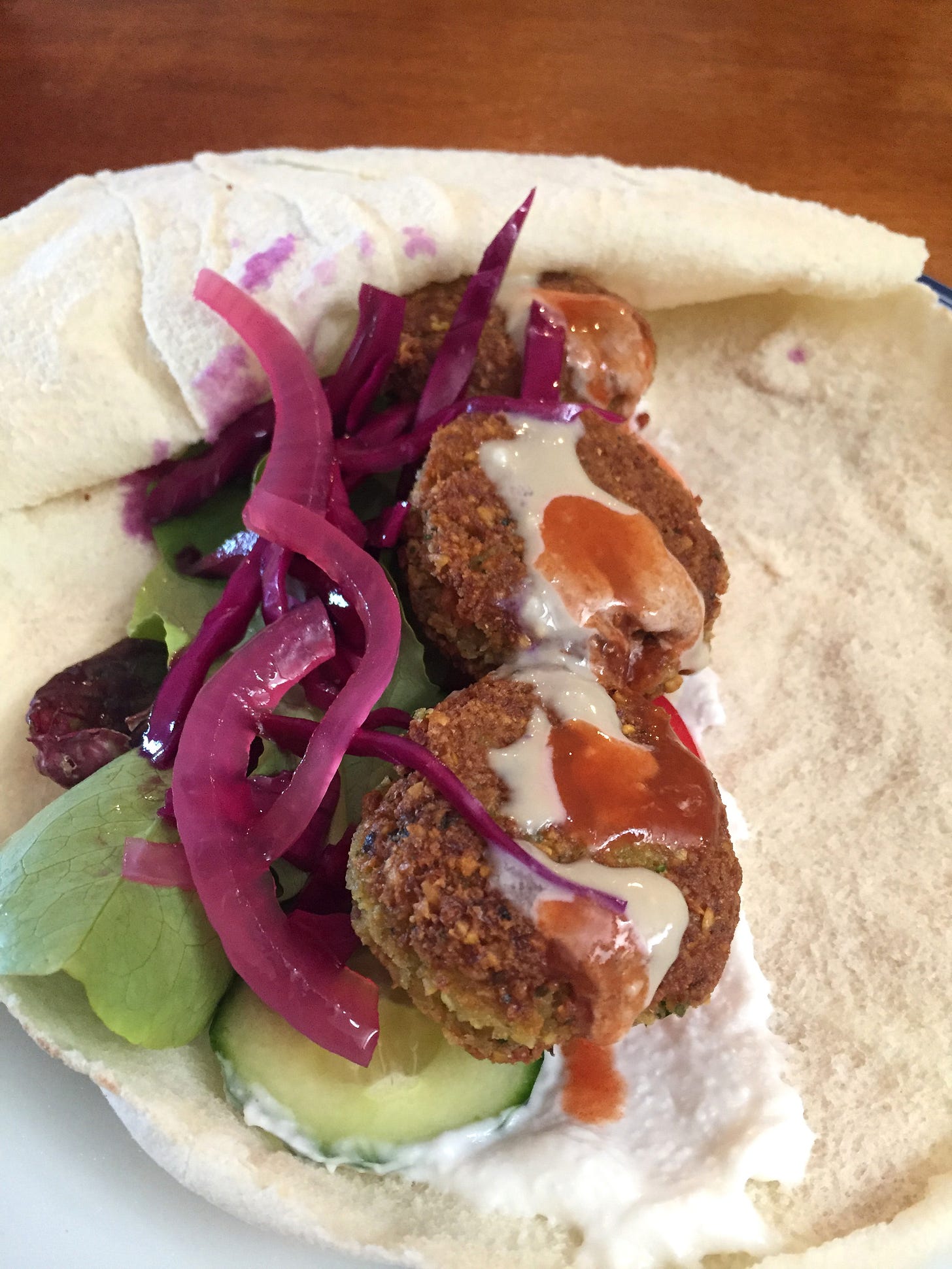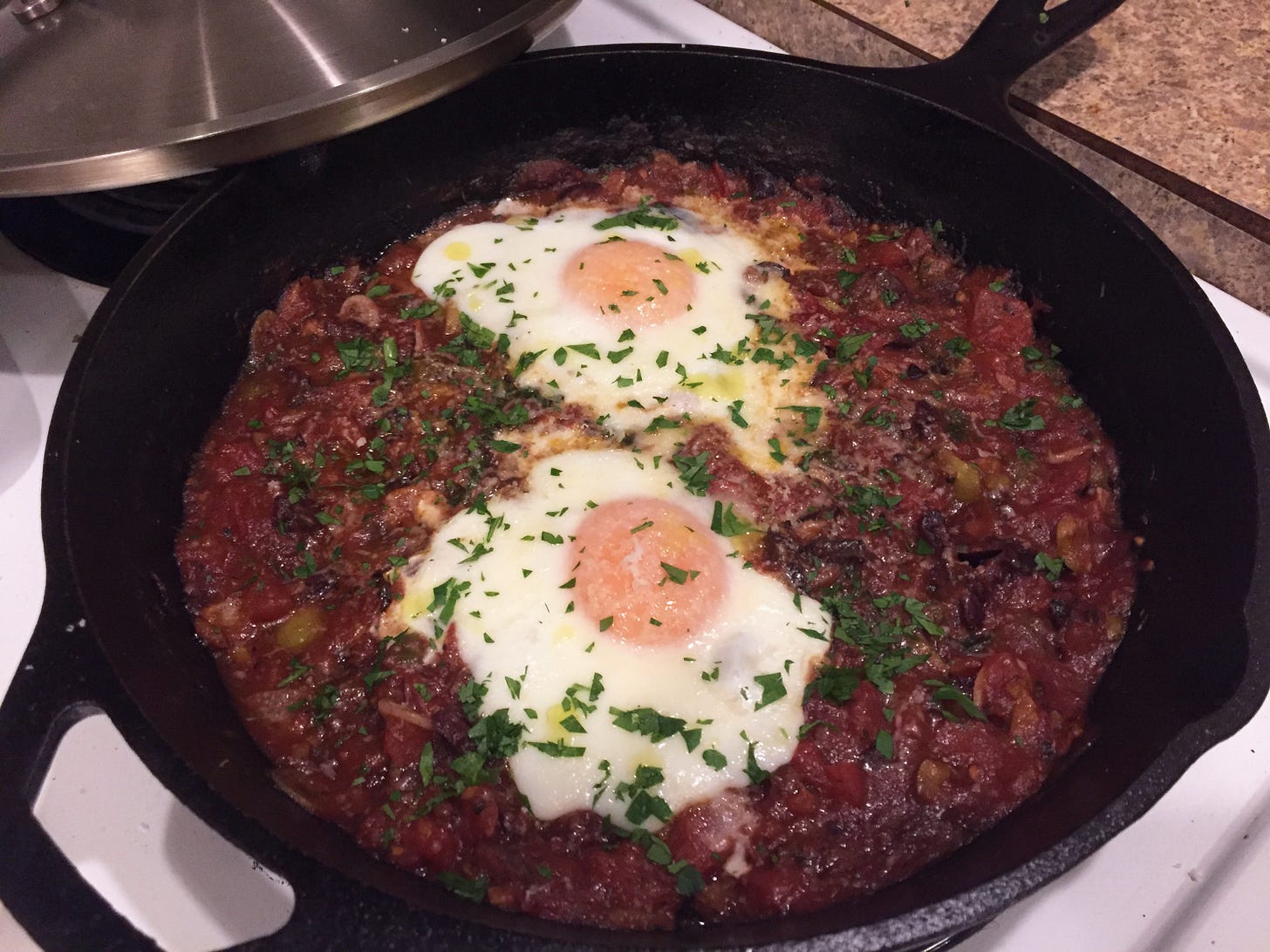My brain has been all over the place this week, and the only things that have been saving me from myself are iphone reminders and synced google calendars (it’s true, we need a national week-long vacation). This weekend I brought my squash and tomato seedlings outside for a bit of sun, and accidentally forgot about them all day and fried all the tomato plants into an early grave (I’m reminded of why I always tend to buy these as seedlings at the nursery instead of starting them myself). But things don’t always turn out as expected, and you just have to roll with it. We’ll see if the second round makes it until June when it’s planting time.
It’s been good having mindless tasks to take care of that don’t require a lot of focus and brainpower, like weeding the garden, counting items for work, or knitting a dishcloth (so that I can avoid starting projects involving things I don’t already know how to do). This week has been a lot of food I can either make on autopilot, or with minimal prep involved, because I simply don’t have the ability right now to think ahead or make creative decisions. I gave myself a nice break from both my computer chair and using my brain on Tuesday when I went for an afternoon bike ride to West Van, singing Bruce Springsteen songs when there was no one else around, and stopping for tacos and a flight of beer at La Cervezería Astilleros’s patio on the way back. My only gripe is that there was no place nearby to lock up my bike, but both the beers and the tacos were excellent; I foresee the salted lime lager and the orange safflower ale becoming favourites of mine this summer.
The first time I tried to make French onion soup, I didn’t realise it was essentially an entire day-long process of simmering broth and caramelizing onions. So I was happy to see an instant pot version in Half-Baked Harvest: Super Simple. I’d made it once before and it’s true that it doesn’t quite compare to the richness of the stovetop method (though it’s definitely not lacking in flavour), but makes up for it by being something you can make in about an hour instead of 8. It makes quite a lot, but I don’t recommend making a half batch unless you have a smaller instant pot, because otherwise the onion caramelization process won’t produce enough liquid to satisfy the instant pot’s requirements. I put a big container in the freezer for a rainy day in the future. Anyway, I love the process of making soup the old-fashioned way so I don’t often use the instant pot for it, but it’s absolutely perfect for something like this, assuming you’re not the kind of person who wants to start making soup in the morning in order to eat it at dinnertime.
The process involves a quick caramelization of the onions by pressure cooking for 20 minutes with plenty of butter and a little sugar or honey, and then pressure cooking the soup after adding broth, wine, and seasonings. But of course the best part of French onion soup is the crispy, savoury, cheesy crouton topping, which we made using multigrain sourdough and Comté, the traditional cheese choice for French onion soup. This cheese is also known as gruyère de Comté, so if you can’t find it, a regular gruyère as the recipe calls for will still be great. While we were eating it we joked about how this soup clearly only came into existence so that restaurants could have something cheap to make to serve to their guests, but adding the qualifier of ‘French’ makes it seem intentional. Hence why “onion soup” sounds sad and “French onion soup” sounds classy. In fact, I think this could be said of almost all soups. Potato soup? Boring. Potato leek soup? Now you’re talkin’!
There was a promo on local restaurant items from the grocery delivery last week, so I ordered a bunch of stuff, and was especially thrilled about the falafel from Nuba— a restaurant I love and have not had the chance to enjoy since 2019. Sadly, it was the only item on my order they were out of stock of on delivery day, and I’d already excitedly ordered all the other things to make falafel wraps, including 2 jars of toum from Jamjar. And that’s how I found myself, after complaining in all my group chats, grumblingly searching the internet for falafel recipes out of spite. I used this basic recipe from Mark Bittman, but if you don’t have NYT access there’s a very similar recipe here (I’d say you can skip the refrigeration after blending the ingredients, as the version I used worked fine without this step).
I’d never made falafel before, except for once in early cookoff days when I didn’t realise it was meant to be made with raw chickpeas, not cooked, and they came out basically like fried hummus which was… not ideal, so that hardly counts. But last summer I did make zucchini & red lentil fritters, which was a similar process. Chickpeas need much more soaking time than red lentils, but remembering to soak them the night before was honestly the most difficult part for me! The rest is just throwing spices, herbs, garlic, and onion in the food processor with the chickpeas, shaping the mixture into patties, and frying. I chose to shallow fry in the wok because I hate deep frying for the amount of oil waste you end up with (not to mention having your entire house smell of fry oil for hours), and it worked fine for the patties. I don’t think it’d do as well with a ball-shaped falafel as the oil wouldn’t reach halfway up as easily, so the centres might not cook through before getting too dark on the outside.
We ate these crispy boys in pita with the toum, some pickled onion & cabbage, a bit of tahini & hot sauce, as well as cucumber, tomatoes, and lettuce to create a tasty vegan wrap that evoked the taste of getting one at Donair City or Babylon Cafe, if not the experience. There were some extra falafel patties, which I put in the freezer (uncooked) for another time. Maybe a mezze plate with olives and feta and mujadara, so I can pretend it’s two years ago and I’m eating at Nuba. Side note: this dinner finished off my jar of pickled cabbage, which I initially only made to use up some leftover red cabbage, but I liked it so much I may have to buy more cabbage to make another jar. The cycle continues.
Eggs in purgatory— also known as uova all’inferno or uova al pomodoro— is an Italian one-pan meal similar to the perhaps better-known Middle Eastern shakshuka, but made using a base of tomatoes instead of peppers. This is generally served as [hangover] breakfast, but I don’t often cook in the morning, and you can basically make anything into a full meal through the magic of #putaneggonit, so I also like it for dinner. Since peppers are naturally sweet, this version is more acidic than shakshuka, which I prefer, and it’s also a lot quicker to make since you can use canned tomatoes instead of chopping and stewing a boatload of bell peppers. I first made this dish a few years ago using Smitten Kitchen’s puttanesca-style recipe, and happily remembered it this week so I could use up some of our bread. If you’re not a fan of olives, first of all, I’m sorry for your life, but also you could try this similar recipe.
As mentioned in a previous newsletter, I have my own preferred method for puttanesca now so I just made that, despite Deb’s note that her recipe is slightly milder than a usual puttanesca because it’s eaten without pasta, because I choose violence (in the form of sodium-laden ingredients). Normally I would use fresh tomatoes for puttanesca, but I chose fire-roasted canned tomatoes here for a shorter cook time and additional savouriness. Once the sauce is thick and flavourful, it’s ready to poach the eggs on top of it, something I’ve found a little tricky in the past with shakshuka— either making the well too deep and having the eggs hit the bottom of the pan, or not deep enough and having the whites spread all over the place, over- or undercooking the egg— but I think it went well this time! It took about 6 minutes with the lid on the pan, which was also the perfect amount of time to toast the bread. I highly recommend this for a quick and delicious dinner, or the perfect hangover brunch… for someone else to cook for you.
Media:
I enjoyed this quick read by Jane Hu about what the McDonald’s filet-o-fish meant growing up to someone within the Chinese diaspora. It’s short so I won’t share too much, but this quote hit home:
I, fancying myself different, pointed out that my parents both loved hamburgers while I, a renegade, preferred the Filet-O-Fish. “Well, I like the Filet-O-Fish most too,” my mother put it candidly. “But it is expensive, so we only buy it for you.”
The idea of struggling parents wanting to give their children a small semblance of luxury while not affording it for themselves is something that I think shows up a lot in immigrant families, and poor/working class families more generally. The author goes on to note that the filet-o-fish now seems underwhelming compared to her memories, but isn’t sure how much of that is due to actual change with the sandwich over the years or because it simply doesn’t live up to her platonic idea of what the sandwich should be… and yet she still finds herself seeking it out in certain situations. Similarly, Jeff always gets Triple O’s whenever we take the ferry to the island, for the nostalgia, and when he was telling someone this and they commented that food on the ferry always ends up being disappointing, he gleefully replied, “the disappointment is part of the nostalgia!”
Thanks for reading— if you enjoyed this newsletter, please share it with someone new! I like providing this to you for free, but it does still involve time and effort, and I would love it if you would donate to relief funds for India’s COVID crisis, if you can. Finally, speaking of McDonald’s, BC folks: here is Ladner’s weird claim to fame.






